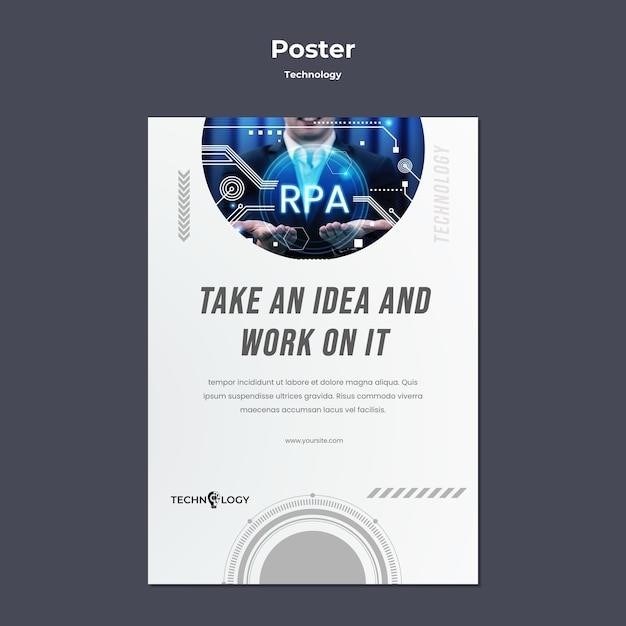Head First Python 3rd Edition⁚ An Overview
This engaging guide uses a unique visual approach to teach Python programming․ It covers fundamentals, web apps, data analysis, and more, making learning fun and effective; Perfect for beginners and experienced programmers alike․
What Makes Head First Python Unique?
Unlike traditional programming manuals, “Head First Python” employs a visually rich, brain-friendly approach․ It leverages images, puzzles, and interactive exercises to boost learning and retention․ This unique methodology goes beyond simple syntax explanations, focusing on a deeper understanding of Python’s concepts and how they interconnect․ The book’s engaging style keeps readers actively involved, making the learning process more enjoyable and less like slogging through dense technical jargon․ This results in a more effective and lasting grasp of the material, transforming the often-daunting task of learning a new programming language into a stimulating and rewarding experience․ The focus on real-world examples and practical applications solidifies the learning process by showing how the concepts learned can be directly applied in various contexts․ The book’s interactive elements encourage active learning, promoting deeper understanding and retention of the key concepts․
Target Audience⁚ Beginners and Experienced Programmers
Head First Python’s adaptable structure caters to a broad spectrum of programmers․ Beginners will find its clear explanations and engaging format ideal for building a solid foundation in Python․ The book’s progressive approach gently introduces fundamental concepts, ensuring a smooth learning curve․ Meanwhile, experienced programmers can leverage the book to deepen their understanding of Python’s nuances and explore advanced techniques․ The inclusion of real-world examples and challenging exercises provides opportunities for all levels to expand their skills and apply their knowledge practically․ Whether you’re a complete novice or a seasoned coder looking to enhance your Python expertise, Head First Python offers valuable insights and engaging learning experiences tailored to your skill level․
Key Features and Learning Approach
Head First Python employs a unique visual learning style, incorporating puzzles, quizzes, and real-world examples to enhance comprehension and retention․
Visual Learning and Interactive Exercises
Unlike traditional programming manuals, “Head First Python” leverages a visually rich format․ The book is packed with diagrams, illustrations, and engaging exercises designed to stimulate your brain and improve learning retention․ Instead of just passively reading, you actively participate in the learning process․ This interactive approach includes numerous hands-on exercises and coding challenges that help solidify your understanding of Python concepts․ The visual elements aren’t just for show; they’re integral to the learning process, making complex topics easier to grasp․ This unique method enhances comprehension and makes learning Python enjoyable rather than a tedious task․ You’ll find yourself actively involved in solving problems and building your skills in a dynamic and engaging way․
Engaging Content and Real-World Examples
Head First Python avoids dry, theoretical explanations․ Instead, it presents concepts through relatable, real-world examples and scenarios․ The book uses engaging narratives and stories to illustrate key Python principles, making the learning process more memorable and enjoyable․ You’ll learn by building practical applications, not just memorizing syntax․ This approach keeps you motivated and helps you understand how Python is used in various contexts․ The examples are designed to be relevant and applicable to your own projects, bridging the gap between theoretical knowledge and practical application․ You’ll find yourself easily grasping concepts and applying them to build your own Python programs with confidence․ This practical approach is what makes Head First Python so effective․
Gradual Progression of Concepts
Head First Python’s strength lies in its carefully structured approach to teaching․ It doesn’t overwhelm you with complex topics upfront․ Instead, it introduces fundamental concepts gradually, building upon previously learned material․ This step-by-step progression allows you to master each element before moving on to more advanced subjects․ The book ensures a solid foundation is established before introducing more challenging aspects of Python programming; This prevents frustration and allows for a deeper understanding of the language’s intricacies․ Complex topics are broken down into smaller, manageable chunks, making the learning curve smoother and more approachable for beginners․ This methodical approach ensures a strong understanding of the fundamentals, leading to greater proficiency in Python programming․ The pacing is well-considered to prevent information overload․

Content Breakdown⁚ What You’ll Learn
Master Python fundamentals, build web applications, wrangle data, and interact with databases and APIs․ Gain practical skills through hands-on exercises․
Python Fundamentals and Data Structures
This section lays the groundwork for your Python journey․ You’ll delve into core concepts such as variables, data types (integers, floats, strings, booleans), operators, and control flow (if-else statements, loops)․ The book expertly guides you through understanding and utilizing fundamental data structures like lists, tuples, dictionaries, and sets․ You’ll learn how to manipulate these structures, perform operations on them, and effectively leverage their unique properties to solve various programming problems․ Expect plenty of practical examples and exercises to reinforce your learning and build your confidence in handling these building blocks of Python programming․ The interactive approach ensures you grasp the nuances of each concept before moving on to more advanced topics․ This solid foundation ensures you’re well-prepared to tackle more complex programming challenges later in the book․
Web Application Development with Python
Dive into the world of web development using Python’s powerful capabilities․ This section guides you through building a complete web application, from initial design to deployment․ You’ll learn to utilize popular frameworks (though specifics aren’t detailed in the provided text), mastering the process of creating dynamic web pages․ The book likely covers handling user input, managing data, and implementing server-side logic․ Expect to work with databases, possibly using tools like SQLite, and learn how to interact with them efficiently․ You’ll also gain experience in handling web requests and responses, ensuring your application functions correctly and interacts seamlessly with users․ The focus is on practical application, allowing you to build a functional web app and understand the underlying principles involved in the process․
Data Wrangling and Analysis Techniques
This section delves into the practical aspects of data manipulation and analysis using Python․ You’ll learn to efficiently handle and clean datasets, addressing inconsistencies and missing values․ The book likely introduces libraries like Pandas, a powerful tool for data manipulation and analysis․ Expect to learn about data structures suitable for handling various data types․ Techniques for data transformation and aggregation are likely covered, allowing you to reshape and summarize your data․ You’ll explore methods for data visualization, creating charts and graphs to better understand trends and patterns within your datasets․ This section likely emphasizes practical application, providing hands-on exercises to solidify your understanding of data wrangling and analysis․ The goal is to equip you with the skills to effectively work with real-world datasets․
Working with Databases and APIs
This section likely covers database interaction using Python, focusing on practical application rather than intricate database administration․ Expect to learn how to connect to databases (like SQLite, mentioned in the provided text), execute queries to retrieve and manipulate data, and potentially interact with different database systems․ The curriculum likely includes working with APIs (Application Programming Interfaces), showing how to access and utilize data from external sources․ You’ll probably learn to make HTTP requests to retrieve data from web APIs and parse the responses into usable formats within your Python programs․ The chapter likely provides examples of integrating APIs into applications, highlighting best practices for error handling and efficient data retrieval from APIs․ The aim is to equip you with the skills to integrate data from various sources into your Python projects․

Additional Resources and Support
Explore online communities, check for errata and updates, and visit the author’s website for further assistance and information․
Online Communities and Forums
Engaging with online communities dedicated to Python programming offers invaluable support and resources for learners of all levels․ These forums often host discussions on specific coding challenges, provide solutions to common errors, and foster collaborative problem-solving․ Active participation in these communities exposes you to diverse perspectives and approaches to programming, enriching your learning experience․ Many experienced Python programmers contribute to these online spaces, making them a rich source of expertise and guidance; Whether you’re grappling with a complex algorithm or seeking clarification on a particular syntax, these online platforms provide a supportive environment for seeking answers and expanding your understanding of the language․ This collective knowledge base can significantly accelerate your learning journey and help you overcome obstacles more effectively than attempting to learn in isolation․
Errata and Updates for the 3rd Edition
Given the rapid evolution of programming languages and libraries, checking for errata and updates is crucial when learning from any programming textbook, including the 3rd edition of “Head First Python․” The publisher’s website, or the author’s site if available, should be your primary source for any corrections or additions to the original published material․ These updates might address minor typos, clarify ambiguous explanations, or reflect changes in Python’s syntax or best practices․ Regularly checking for and implementing these corrections ensures you’re working with the most accurate and up-to-date information, minimizing confusion and potential errors in your code․ Staying current with errata will enhance your learning experience and prevent frustration caused by outdated or incorrect information․
Author’s Website and Contact Information
While the provided text doesn’t directly offer the author’s website or contact details, locating this information is beneficial for several reasons․ The author’s personal website might contain supplementary materials, further explanations of concepts from the book, or updates regarding the “Head First Python” 3rd edition․ It could also include details about other projects or publications by the same author, which may be of interest to readers deepening their programming knowledge․ Furthermore, contacting the author directly (if contact information is provided) could allow you to ask questions or report errors not covered in any official errata․ Searching online using the author’s name, “Head First Python,” and “3rd Edition” should yield relevant links; Remember to check the publisher’s website as well, as they may provide a link to the author’s contact information or a dedicated page for reader inquiries․
Where to Find and Download the PDF
Legally obtain the PDF through the official publisher’s website or reputable ebook retailers․ Beware of illegal downloads; copyright infringement is a serious issue․
Official Publisher’s Website
The most reliable source for acquiring a legitimate copy of “Head First Python, 3rd Edition” in PDF format is directly from the publisher’s official website․ This ensures you’re getting an authorized version, free from potential malware or errors found in unauthorized uploads․ Purchasing from the official source also supports the authors and publishers, encouraging them to create more valuable learning resources in the future․ While other online platforms might offer the book, prioritizing the official website helps guarantee a high-quality, error-free, and legally sound download experience․ Remember to check for any digital rights management (DRM) restrictions that might apply to your chosen purchase method․ Directly supporting the publisher is the best way to ensure you have a clean, legal copy of the book and contribute to the continued production of quality educational materials․
Third-Party Online Resources (Caution Advised)
While various third-party websites might offer “Head First Python, 3rd Edition” PDFs for download, exercising extreme caution is crucial․ These sources often lack verification, increasing the risk of encountering corrupted files, malware, or versions riddled with errors․ Downloading from unofficial sites might infringe copyright laws, leading to legal consequences․ The quality of the content is also unreliable; the PDF could be incomplete, illegible, or contain inaccurate information, hindering your learning process․ It’s far safer and more beneficial to obtain the book through authorized channels, ensuring a quality learning experience without jeopardizing your computer’s security or breaching copyright regulations․ Prioritizing legitimate sources always guarantees a superior and legally sound learning experience․
Potential Copyright Issues
Downloading “Head First Python, 3rd Edition” PDFs from unauthorized sources raises significant copyright concerns․ The book is intellectual property protected by law․ Downloading or distributing copyrighted material without permission from the publisher infringes these rights․ This can lead to legal repercussions, including hefty fines or lawsuits․ Respecting copyright is crucial; it protects authors and publishers, ensuring they receive compensation for their work․ Legitimate access, such as purchasing the book or using authorized online platforms, supports creators and guarantees you a legal copy free of any legal issues․ Choosing legal options is essential for responsible learning and ethical engagement with copyrighted materials․ Always prioritize legal and ethical access to educational resources․
